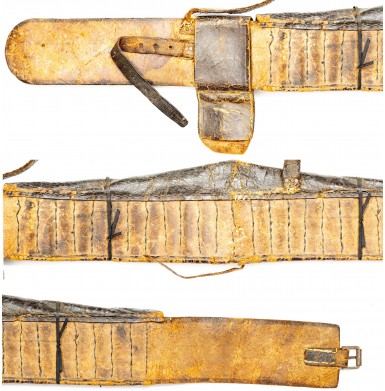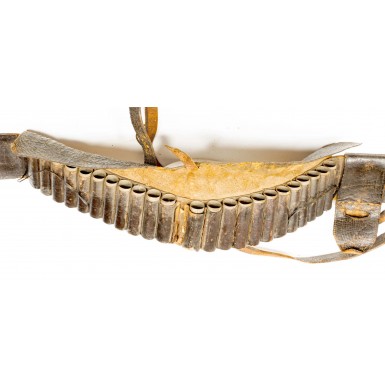Early 19th Century American Militia Cartridge Belt - Possibly for use with the Hall Rifle
- Product Code: ALKH-1356-SOLD
- Availability: Out Of Stock
-
$1.00
This is a wonderful example of early 19th Century American military ingenuity, a cartridge belt, rather than box. This interesting cartridge belt was formerly in the collection of the late William H. Guthman, one of the leading experts on early American militaria and material culture and longtime appraiser on PBS’ Antiques Roadshow. Bill had generally considered this to be an infantry cartridge belt dating from around the period of the War of 1812, but a more detailed inspection suggests that it might be something more somewhat more interesting.
The thick leather belt is nominally 37.5” long and 2.8125” wide with a rounded end and an 8.75” billet on the reverse that engages a 1” hand forged iron roller buckle on the opposite side. The belt originally had 24 cartridge tubes mounted on it, with full-coverage leather tubes and sheet tin liners. The tubes are covered with a leather flap that was intended to protect the paper cartridges from the elements. One of the tubes from the center of the belt is no missing, apparently due to wear to the stitching as the missing tube was near the center of the majority of the flex the belt would undergo when in use. The belt has bayonet frog mounted on the left side, which measures about 2.375” wide and 6.375” long. The frog is cut to receive the frog hook form a socket bayonet scabbard and to keep the scabbard in place. The belt also has a “Sam Browne” belt style shoulder strap to help support the weight of the waist belt. The cross belt is .68” wide and is adjustable via another 1” hand forged iron roller buckle. The cross belt passes across the chest and back, passing over the right shoulder, when in use. As designed, the ammunition belt is worn with the closure in the back and all of the cartridge tubes in front, in the manner of a “belly box”.
Despite Mr. Guthman’s assumption that this was an infantry belt, I tend to think it might be something else. Bill’s primary motivation to categorize it that way was likely the presence of the bayonet frog. A detailed inspection reveals that while the tin tubes vary slightly in their inner diameters and are no longer perfectly round, they are nominally about .65” in diameter and are about 2.75” long. This measurement suggests that this was never a musket ammunition belt, as the tubes are too small to accept the musket ammunition of the period. Standard round ball ammunition for a .69 caliber US musket was .65 caliber for the large ball, with .33 caliber buckshot included in the cartridge for buck and ball loads. Neither pattern of cartridge would fit in the .65” tubes. This means the belt carried ammunition that was no more than about .62-.64” in diameter, including the layers of paper wrapping. This would suggest that the projectile was probably in the .50-.58 caliber range at most. This certainly limits the potential firearms that this belt might have been used with. One thought would be pistol ammunition, which was certainly in that caliber range during the first part of the 19th century, the second thought would be some sort of rifle ammunition.
The length of the tubes certainly suggests the ammunition was for longarms and not handguns, so we can probably rule out the possibility that this is a pistol belt. Additionally, a pistol would not require a bayonet. It is the very presence of the bayonet frog certainly raises an interesting question. During the period, rifles were rarely equipped with bayonets, so there would be no need for a bayonet frog for a rifle. The only exception that immediately comes to mind during the first quarter or half of the 19th century would be the US Model 1819 Hall Rifle. That was the first US rifle that included a socket bayonet as one of its standard appendages.
While “belly boxes” were not uncommon during the Revolutionary War and through the Federal Era, particularly for militiamen, cartridge belts were much less common. In fact, the handful of extant examples from the Revolutionary War are specifically for use by mounted troops. As noted in Harold Peterson’s The Book of the Continental Soldier, the Continental Congress recommended that mounted troops be provided with “a cartridge-box to buckle around the waist, with twelve tin pipes for the cartridges.” Peterson shows two examples of such boxes on page 69 of his book and they are quite similar to this belt, particularly the leather one from the Robert L. Miller collection pictured at the top of the page. That belt is substantially similar with the two primary differences being the leather forms a single pouch for 12 tubes, rather than individual pockets for the tubes, and of course there only 12 and not 24. This can be partially explained by the necessity that tubes for most of the muskets and carbines of the Revolutionary War period would have to be closer to .70”.
So, looking at the belt design and the presence of the over the shoulder cross belt, it is almost certain that this belt was designed for use by mounted troops. The cartridge tubes are too small for musket ammunition and apparently too long for pistol ammunition. The belt has a bayonet frog that can only be removed by detaching the over the should belt and then re-stitching the cross belt. All of this suggests that the belt was designed for use with a long arm that accepted a socket bayonet with a caliber that could not exceed about .58 for the projectile and will likely somewhat smaller than that. It is worth noting that a similar, if more advanced version of this type of cartridge belt/box was used by the state of South Carolina during the Civil War, for issue with the Morse Carbine.
It is my belief that this cartridge belt was intended for mounted state militia armed with rifles, quite possibly Hall’s Patent .52 Caliber Breechloading Rifles that were used extensively by southern state militias during the Seminole War period. While I would very much like to think that this was a Revolutionary War or War of 1812 accouterment, I think it is probably a little later than that and was used during the 1820s and 1830s, most likely while fighting in Florida during the Seminole Wars.
The belt is in about VERY GOOD condition considering its age and the amount of use it has seen. The leather is somewhat stiff from age and has some creases and misshaped areas due to drying and age. However, the leather remains pliable enough to be able to handle and display the belt and potentially even put it on a mannequin. The leather has embossed decorations, most notably on the flap that covers the cartridge tubes. The leather has some flaked surface loss of finish, as well as some of the leather. There are sewn repairs here and there, reinforcing and reattaching some of the loops, the flap and the cross belt. One end of the cross belt is reattached with small iron nails as well. The closure tab in the middle of the flap is an old, added replacement and the thong at the bottom of the belt center that could thread through the tab is old and detached from the main body of the belt. Two pieces of narrow black ribbon are wrapped around the flap to hold it closed near the edges and tied in knots on the back side. The roller buckles remain functional and show moderate oxidation and some surface roughness. The belt has a nice, dry and untouched appearance with a wonderful look.
While I wish I could be definitive about what the belt was really intended to go with, I think the information provided above combined with the physical features point strongly to this being a mounted militia belt for use by a rifleman. As the only rifle of the period that was regularly equipped with a bayonet was the Hall Rifle, I think that is a strong possibility. This would be wonderful addition to any collection of 19th century American militaria and I think it would be particularly good for a collection that concentrated on the southern state militias of the Seminole Wars period.
SOLD
Tags: Early, 19th, Century, American, Militia, Cartridge, Belt, Possibly, for, use, with, the, Hall, Rifle










